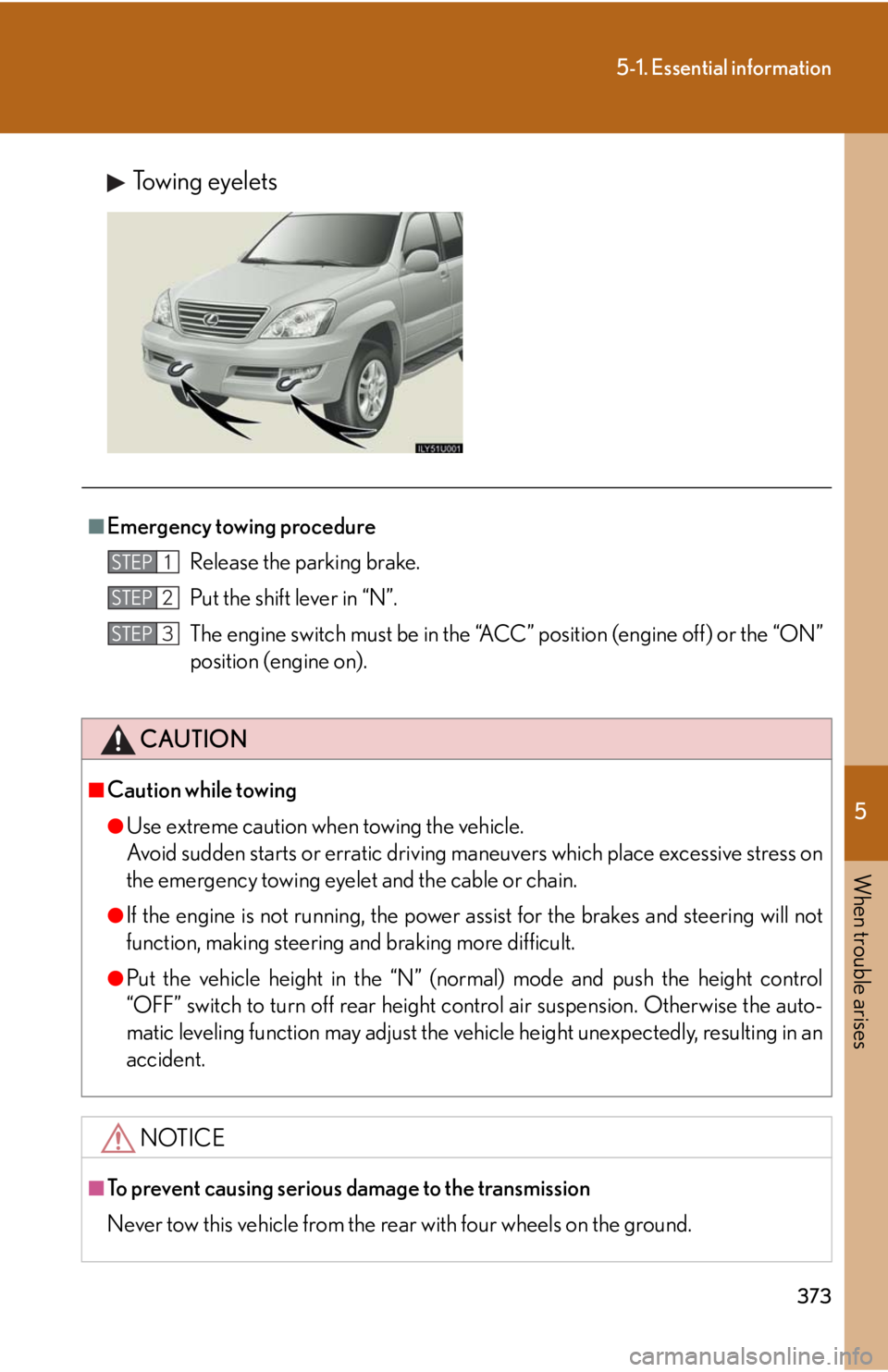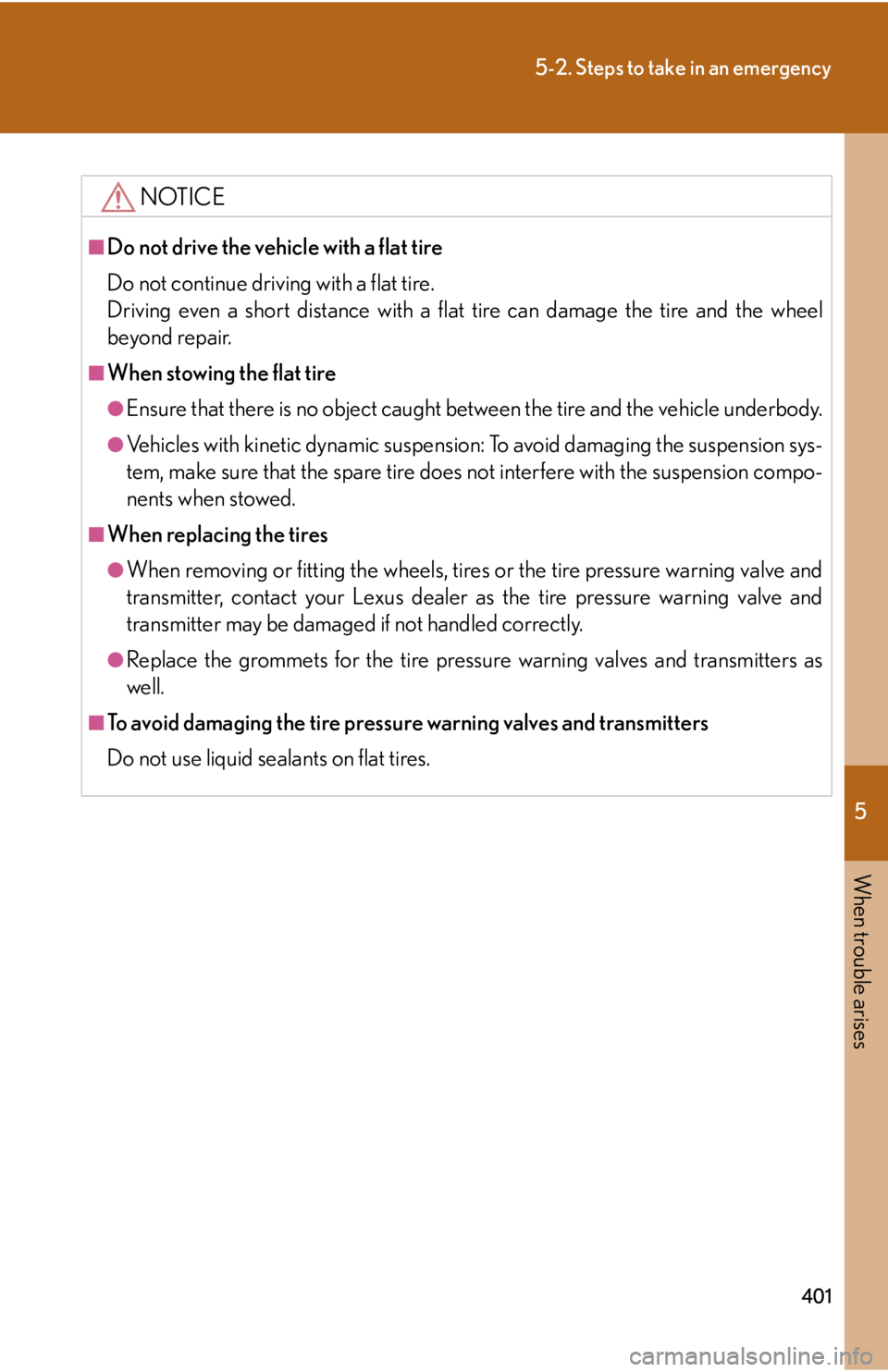air suspension Lexus GX470 2008 Operating the lights and windshield wipers / LEXUS 2008 GX470 (OM60D82U) User Guide
[x] Cancel search | Manufacturer: LEXUS, Model Year: 2008, Model line: GX470, Model: Lexus GX470 2008Pages: 458, PDF Size: 7.3 MB
Page 185 of 458

185
2-5. Driving information
2
When driving
CAUTION
■To avoid accident or injury
●The total trailer weight (trailer weight plus the weight of cargo) must not exceed
6500 lb. (2948 kg).
●If a trailer and cargo weight over 2000 lb. (907 kg), use a sway control device
with sufficient capacity.
●The gross combined weight (sum of your vehicle weight plus its load and the total
trailer weight) must not exceed 12000 lb. (5443 kg).
●Do not exceed the trailer hitch assembly weight, gross vehicle weight, gross axle
weight and trailer tongue load capacities.
●Never load more weight in the back than in the front of the trailer. About 60% of
the load should be in the front half of the trailer, and the remaining 40% in the
rear.
●Set the vehicle height to the “LO” mode and turn off the rear height control air
suspension to prevent the vehicle he ight from automatically changing.
●The tow hitch receiver installed on your vehicle must never be used on another
vehicle
■Hitches
●If you wish to install a trailer hitch, contact your Lexus dealer.
●Use only a hitch that conforms to the total trailer weight requirement.
●Follow the directions supplied by the hitch manufacturer.
●Lubricate the hitch ball with a light coat of grease.
●Remove the trailer hitch whenever you are not towing a trailer. After removing
the hitch, seal any mounting hole in the vehicle body to prevent entry of any sub-
stances into the vehicle.
■When towing a trailer
●If the total trailer weight exceeds 1000 lb . (453 kg), trailer brakes are required.
●Never tap into your vehicle’s hydraulic system, as this will lower the vehicle’s brak-
ing effectiveness.
●Never tow a trailer without using a safety chain securely attached to both the
trailer and the vehicle. If damage occurs to the coupling unit or hitch ball, there is
danger of the trailer wandering into another lane.
Page 357 of 458

357
4-3. Do-it-yourself maintenance
4
Maintenance and care
Fuse layout and amperage ratings■ Engine compartment
FuseAmpereCircuit
1ALT140
Charging system, AM1, HEATER,
CDS FAN, FR FOG, DEFOG, AIR
SUS, AC INV, SEAT HEATER, OBD,
STOP, J/B, RR AC, MIR HEATER,
BATT CHG, TOWING BRK, TOW-
ING
2HEATER50Air conditioning system
3AIR SUS50Rear height control air suspension
4AM150
ACC, CIG, IG1, FR WIP-WSH, RR
WIP, RR WSH, DIFF, ECU-IG,
TEMS, STA
5TOWING BRK30Trailer brake controller
6J/B50
P FR P/W, P RR P/W, D RR P/W, D
P/ S E AT, P P/ S E AT, TA I L , PA N E L ,
POWER OR TI&TE
7BATT CHG30Trailer sub battery
Page 358 of 458

358
4-3. Do-it-yourself maintenance
FuseAmpereCircuit
8TOW I N G40Trailer lights
9CDS FAN20Electric cooling fan
10RR A/C30Rear air conditioning system
11MIR HEATER10Outside rear view mirror defogger
12STOP10
Stop lights, high mounted stoplight,
shift lock control system, vehicle sta-
bility control system, electronic mod-
ulated suspension, rear height control
air suspension, multiport fuel injec-
tion system/sequential multiport fuel
injection system
13AC INV15Power outlet (115V AC)
14FR FOG15Front fog lights
15OBD7. 5On-board diagnosis system
16HEAD (LO RH)10Right hand headlight (low beam)
17HEAD (LO LH)10Left hand headlight (low beam)
18HEAD (HI RH)10Right hand headlight (high beam)
19HEAD (HI LH)10Left hand headlight (high beam)
20EFI NO.210
Multiport fuel injection system/
sequential multiport fuel injection
system
21HEATER No.27. 5Air conditioning system
22DEFOG30Rear window defogger
23AIRSUS NO.210Rear height control air suspension
24S E AT H E AT E R20Seat heaters
Page 361 of 458

361
4-3. Do-it-yourself maintenance
4
Maintenance and care
■Driver’s side instrument panel
FuseAmpereCircuit
1IGN10
Multiport fuel injection system/
sequential multiport fuel injection
system, vehicle stability control sys-
tem
2SRS10SRS airbag system, front passenger
occupant classification system
3GAUGE7. 5Gauges and meters
4ST27. 5
Multiport fuel injection system/
sequential multiport fuel injection
system
5FR WIP-WSH30Windshield wipers, windshield
washer
6TEMS20Electronic modulated suspension
7DIFF20Four-wheel drive system
8RR WIP15Rear window wiper
9D P/SEAT30Driver’s power seat
10P P/SEAT30Front passenger’s power seat
11PWR OUTLLET15Po w e r o u t l e t ( 1 2 V D C )
Page 373 of 458

5
When trouble arises
373
5-1. Essential information
Towing eyelets
■Emergency towing procedureRelease the parking brake.
Put the shift lever in “N”.
The engine switch must be in the “ACC” position (engine off) or the “ON”
position (engine on).
CAUTION
■Caution while towing
●Use extreme caution when towing the vehicle.
Avoid sudden starts or erratic driving maneuvers which place excessive stress on
the emergency towing eyelet and the cable or chain.
●If the engine is not running, the power assi st for the brakes and steering will not
function, making steering and braking more difficult.
●Put the vehicle height in the “N” (normal) mode and push the height control
“OFF” switch to turn off rear height co ntrol air suspension. Otherwise the auto-
matic leveling function may adjust the vehicle height unexpectedly, resulting in an
accident.
NOTICE
■To prevent causing serious damage to the transmission
Never tow this vehicle from the rear with four wheels on the ground.
STEP1
STEP2
STEP3
Page 377 of 458

5
When trouble arises
377
5-1. Essential information
If you think something is wrong
If you notice any of the following symptoms, your vehicle probably needs
adjustment or repair. Contact your Lexus dealer as soon as possible.
■Visible symptoms
●Fluid leaks under the vehicle
(Water dripping from the air conditioning after use is normal.)
● Flat-looking tires or uneven tire wear
● Engine coolant temper ature gauge needle continually points
higher than normal
■ Audible symptoms
●Changes in exhaust sound
● Excessive tire squeal when cornering
● Strange noises related to the suspension system
● Pinging or other noises related to the engine
■ Operational symptoms
●Engine missing, stumbling or running rough
● Appreciable loss of power
● Vehicle pulls heavily to one side when braking
● Vehicle pulls heavily to one side when driving on a level road
● Loss of brake effectiveness, sp ongy feeling, pedal almost touches
the floor
Page 391 of 458

5
When trouble arises
391
5-2. Steps to take in an emergency
If you have a flat tire
Remove the flat tire and replace it with the spare provided.
■Before jacking up the vehicle
●Stop the vehicle on a hard, flat surface.
● Set the parking brake.
● Shift the shift lever to “P”.
● Turn off the rear height control air suspension. ( P. 1 4 9 )
● Stop the engine.
● Turn on the emergency flashers.
■ Location of the spare tire, jack and tools
Wheel nut
wrench
Spare tire
Jack
Tools
Jack handle and extensions
Page 399 of 458

5
When trouble arises
399
5-2. Steps to take in an emergency
CAUTION
■Using the tire jack
Improper use of the tire jack may lead to death or injuries due to the vehicle sud-
denly falling off the jack.
●Do not use the tire jack for any purpose other than replacing tires or installing and
removing tire chains.
●Only use the tire jack that comes with this vehicle for replacing a flat tire.
Do not use it on other vehicles, and do not use other tire jacks for replacing tires
on this vehicle.
●Always check that the tire jack is securely set to the jack point.
●Be sure to turn off the rear height co ntrol air suspension and stop the engine.
●Do not raise the vehicle while someone is in it.
●When raising the vehicle, do not put an object on or under the jack.
●Do not raise the vehicle to a height greate r than that required to replace the tire.
●Use a jack stand if it is necessary to get under the vehicle.
●Do not put any part of your body under the vehicle supported by a jack.
●Do not start or run the engine while your vehicle is supported by the jack.
Take particular care when lowering the vehicle to ensure that no one working on or
near the vehicle may be injured.
■Using the jack handle
Tighten all the jack handle bolts securely using a Phillips-head screwdriver, to pre-
vent the extension parts from coming apart unexpectedly.
Page 401 of 458

5
When trouble arises
401
5-2. Steps to take in an emergency
NOTICE
■Do not drive the vehicle with a flat tire
Do not continue driving with a flat tire.
Driving even a short distance with a flat tire can damage the tire and the wheel
beyond repair.
■When stowing the flat tire
●Ensure that there is no object caught between the tire and the vehicle underbody.
●Vehicles with kinetic dynamic suspension : To avoid damaging the suspension sys-
tem, make sure that the spare tire does not interfere with the suspension compo-
nents when stowed.
■When replacing the tires
●When removing or fitting the wheels, tires or the tire pressure warning valve and
transmitter, contact your Lexus dealer as the tire pressure warning valve and
transmitter may be damaged if not handled correctly.
●Replace the grommets for the tire pressure warning valves and transmitters as
well.
■To avoid damaging the tire pressu re warning valves and transmitters
Do not use liquid sealants on flat tires.
Page 446 of 458

446
Abbreviation list
Abbreviation/Acronym list
ABBREVIVATIONSMEANING
A/CAir Conditioning
ABSAnti-Lock Brake System
ACCAccessory
ALRAutomatic Locking Retractor
CALCalibration
CRSChild Restraint System
DACDownhill Assist control system
DISPDisplay
ECUElectronic Control Unit
EDREvent data recorder
ELREmergency Locking Retractor
GAWRGross Axle Weight Ratings
I/MEmission inspection and maintenance
INTIntermittent
KDSSKinetic Dynamic Suspension System
LEDLight Emitting Diode
LSDLimited Slip Differential
MMTMethylcy clopentadienyl Manganese Tricarbonyl
M + SMud and Snow
MTBEMethyl Tertiary Butyl Ether
OBDOn Board Diagnostics